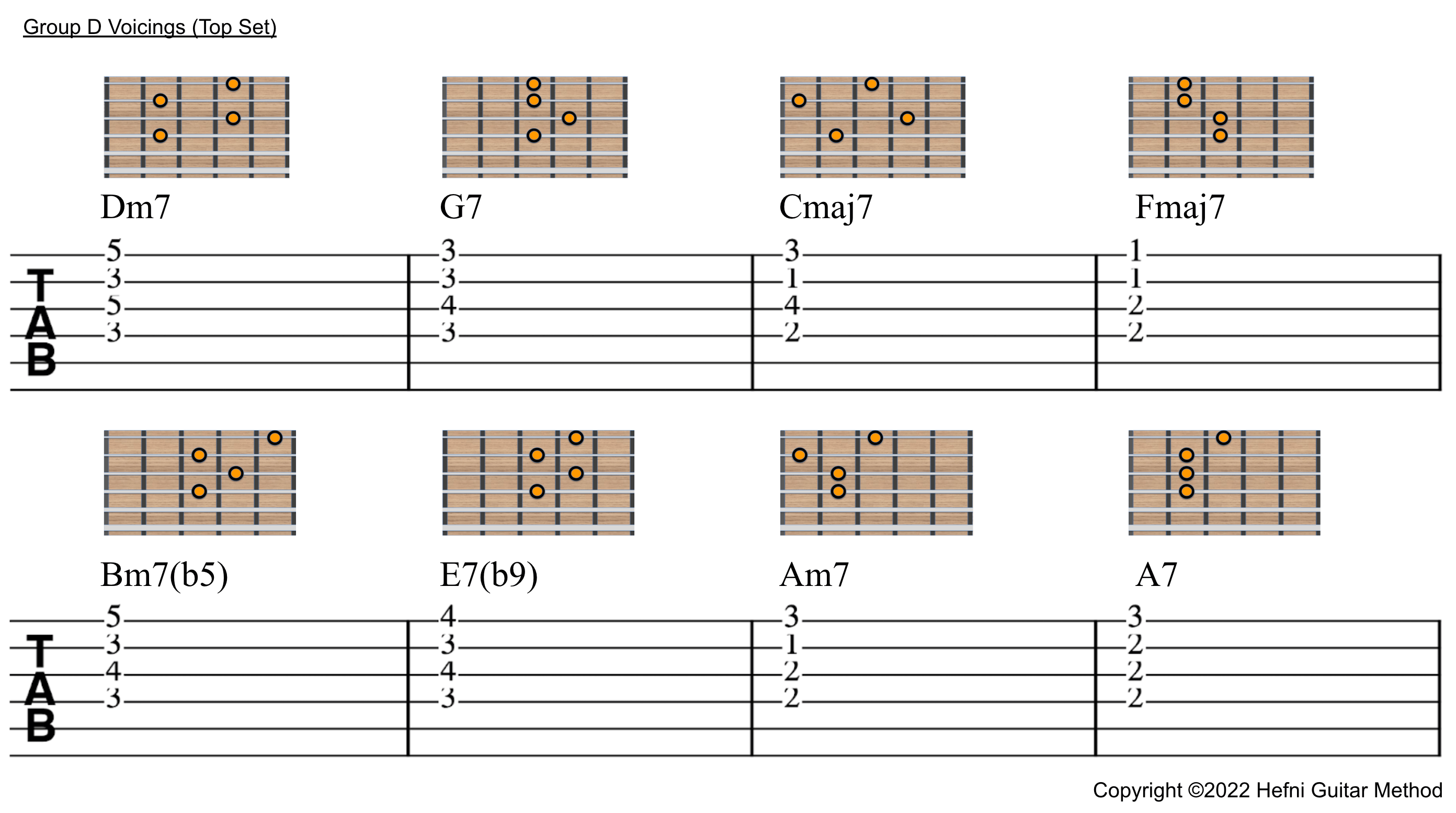Welcome to the Jazz Chords Workshop Lesson 8.
This week’s lesson introduces the final voicing group for the major- and minor II V I progression on the top 4 strings in the key of C major. This voicing group spans the 13th to 17th frets. Alternatively, we can transpose this 12 frets down (i.e. one octave) to the 1st to 5th frets.
Therefore, let us call this the top structure of Group D Voicings (for Jazz).
Click the video below to watch the lesson.
Learning Aids
The chord shapes and TABs for this lesson are provided as follows.

Primary Takeaways
Here are the main takeaways of lesson 8:
1. Each new voicing group starts with the previous voicing group’s Amin7 chord shape.
Incidentally, this is actually by design so that it helps make the learning easier. Granted, there is a lot of knowledge to acquire in the pursuit of chord tone soloing. Therefore, think of this as a ‘hack’ to help with the learning. You will find, I also use this approach in the later scale series particularly the Hefni Pentatonic System.
2. The chord structures for Minor 7th and Dominant 7th differ by only one note
This point is obvious for those learners who already have music theory. However, many guitar players do not have music theory knowledge. While learning music theory does have its benefits, I always advocate learning guitar by playing first and understanding later. As such, I designed this chords series using diagrams instead of theory. Therefore, if you stick to using only the diagrams (and/or TABS) you will be fine. The main difference between minor 7th and dominant 7th chords is how they are used. You can substitute a minor chord (triad) with a minor 7th chord. Similarly you can substitute a major triad (especially the V chord in the key) with a dominant 7th chord.
3. The Amin7 and A7 chord structures differ by one note.
This section contains some theory for those interested. Notwithstanding, you may skip this section if you like.
The chord tones of Amin7 are A, C, E and G while the chord tones of A7 are A, C#, E, G.
Comparing between the 2, the only difference is the C and C#notes which are the minor 3rd and the major 3rd of the minor 7th and dominant 7th chords respectively. Since we are sticking to the key of C major, the notes are therefore C, D, E, F, G, A and B. (there are no #’s or b‘s in C major)
However, since there is a C# in A7, this chord clearly does not belong to the key of C major. In fact, the only function of A7 is to resolve the progression back to Dmin7 in bar 1 so that the progression becomes repeatable. We will discuss how to solo over the A7 when we come to the series on scales.
The main takeaway here is to change between Amin7 to A7, we need only move 1 note.
Tips for better learning
Building upon what we have learnt in previous lessons, the following still hold true and may help you remember the concepts.
-
-
-
- The Dm7 and Bm7(b5) chords differ by one note.
- The Cmaj7 and Amin7 chords differ by one note.
- Remember that E7(b9) chord shape is always the same in the same string set.
- The Fmaj7 functions to connect the major II V I to the minor II V I.
- The A7 functions to connect the minor II V I back to the major II V I making it cyclic.
- Only the E7(b9) and A7 are not diatonic to the scale. They are ‘borrowed’ temporarily from other scales/keys.
-
-
Use all available resources for your learning.
The lesson videos go through the chord voicings rather quickly. They were designed to keep the video short but also to demonstrate the changes. However, the chord diagrams have been embedded in the videos themselves so if you so choose, you may simply pause the video at the relevant times.
Notwithstanding, I have also included the chord diagrams as well as relevant TABs in the image above. Therefore, those among you who learn better through TABs, these are presented as such for your learning. We all learn differently so choose which approach best suits your or perhaps use them both. These chord workshops are a free resource in any case.
Follow us on Facebook, Instagram and Youtube.
